







IPCS |
International Programme on Chemical Safety |
CHEMICAL SAFETY TRAINING MODULES
PART IV: TRANSPORT AND STORAGE
3. Transport and storage of dangerous goods
Whenever dangerous goods are transported certain measures should be taken to ensure that the potential risks are adequately communicated to all who may come into contact with the goods in the course of the transport. This can be accomplished through marking and labelling of packages to indicate the hazards of the consignment, through including relevant information in the transport documents, and by placing placards on the transport units: containers and vehicles.
3.1. Labels, marking, documents
Each package should be marked with the appropriate shipping name, hazard class and UN number, followed by packing group reference:
| ACETONE 3 UN 1090 II |
Detailed instructions on how dangerous goods should be classified and packed are given in international agreements and national provisions.
Labels should be placed on containers and vehicles so that they are clearly visible.
During the transport of dangerous goods, the appropriate warning labels, based on the classification of dangerous goods into the 9 classes described above, should be on every single package.
Only one danger class label should normally be fixed on a package. However, if the substance or article presents more than one significant risk, such as fire and poisoning, the package should bear labels indicating important subsidiary risks.
The documentation for the transport of dangerous goods should contain:
Transport document containing
In addition:
Declaration or certificate that the consignment offered can be accepted for transport, and that the goods are properly packed, marked and labelled.
| Transport by road may take place as bulk materials, or in
containers and tanks. The detailed technical requirements for different transport methods are usually given in national regulations. The transporter should check that the following documents are attached:
Every transport unit carrying dangerous goods should be equipped with:
|
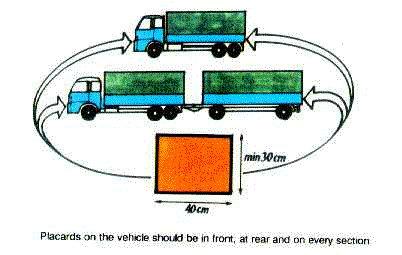
|
3.3. Incompatible dangerous goods
| Detailed instructions pertaining to classified dangerous
goods may also restrict the transport of specific goods together in the same vehicle, or
the minimum distances between two such packages may be given. Those loading the goods have to rely on the information found on packages and transport documents. Opening of the transport containers or the packages during the transport or intermediate storage is not permitted. Once the labelling is properly completed, loading personnel can use the attached key symbols to judge how to construct the load according to regulations and in a safe way. |
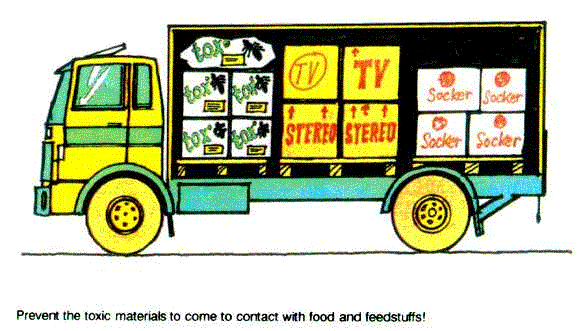 |
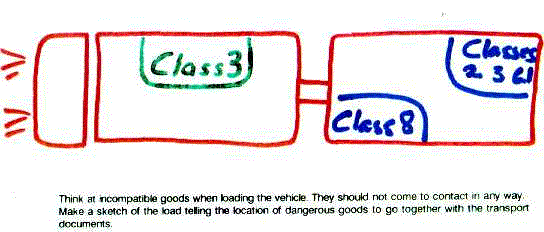
Dangerous goods require special treatment, equipment, extra vehicle crews and supervision when stored, handled, parked, and at places of loading and unloading.
Detailed instructions in international and national provisions specify quantity limits for certain dangerous substances. These maximum package quantities can be transported in one transport unit, and the above-mentioned special precautions need not all to be applied. Such limits are given in the UN Recommendations on the Transport of Dangerous Goods. They are adapted and more detailed in the European Agreement Concerning the Carriage of Dangerous Goods by Road (ADR).
| Safety measures should be part of procedure from the first
request for transport up to the delivery of the goods at the end-point; including the
cleaning of the vehicle afterwards. All levels of personnel involved should be well informed and these people should share the responsibility. Safety measures should include organizational, personnel and engineering aspects, and co-operation between operational staff during the transport should be emphasized. Collaboration between the employer and employees is essential. Collaboration with authorities, such as responsible community and health care institutions and Labour Inspectorate is equally important in order to exchange information and plan for emergencies. |
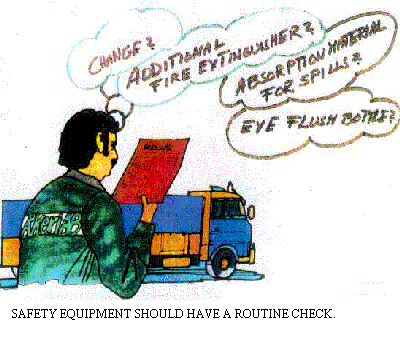
|
4.1. Organizing safety communication
Proper communication within the transport chain is the basis for all other safety measures.
Safety activities are targeted to:
This should involve all parties in the workplace. The task could be given to a committee including representatives of different parts of the transport company.
The committee could consider emergency planning and safety education. Ideas from both workers and the employer should be encouraged and discussed.
4.2. Organizing safety measures
Transport order, booking
Whether the batch contains dangerous goods should be declared already at accepting a transport order. If the batch does or is suspected to contain dangerous goods, the consignor should be reminded of the need to label the goods according to regulations and to prepare documents which include instructions in the local language in case of emergency or spillage.
Some companies have developed checklists of different aspects of information, which the consignor can use to describe the load in order to facilitate the communication between different stages of the transport chain.
If the cargo is transported in a tank-container or as bulk transport, a special check should be made that the vehicle is properly equipped, that proper placards are chosen, that the vehicle, its pipes and connections are empty and clean, and that the protective equipment is intended for those hazards the transported goods can cause (such as provision of the right type of filter for the driver's gas mask).
Loading
| Before leaving the loading place all documents should be
checked. Always remove old documents from the vehicle to avoid any misunderstanding in
case of an emergency. See that the documents are completed. If passing through customs,
check that the emergency instructions are written in the appropriate languages. The
packages and containers should not be broken, and the actual amount should be the same as
stated in the documents. Dangerous goods should always be well attached to avoid load
movements during transport and they should be loaded away from food and animal feedstuffs.
Attach the placard to the vehicle. Remember grounding to avoid static electricity, and personal protective equipment when loading dangerous goods in/from tank-containers. A sketch of the load showing where the dangerous goods are situated could save time in unloading. |
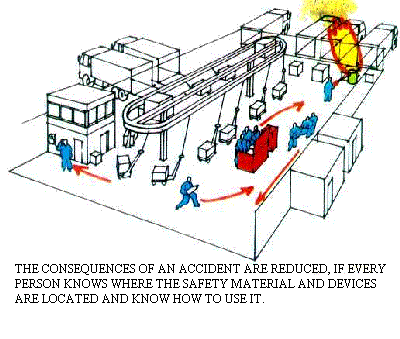
|
Unloading and re-transport
A check should be made that the documents are always attached to the goods. To avoid unnecessary risks an intermediate storage should be planned, according to the class to which the goods belong, to avoid contacts between incompatible chemicals. A checklist for re-transport helps the workers in the storage area and enhances safety.
Some dangerous goods must be under surveillance at all times, such as explosives and organic peroxides. Some other dangerous goods need limited surveillance while parked in a restricted area or isolated place if the amount exceeds specified quantities.
Delivery
You should check that loaded dangerous goods have not moved and that the packages/containers are not leaking. Follow cleaning instructions described in the attached documents in case of a spillage.
Dangerous goods can be delivered only to the authorized persons and should not be left without surveillance.
Check that the name(s) of the goods and the amounts correspond to those in documents. In the case of liquids being transported in a tank-container, check that connections and pipes are not leaking. Supervise the unloading to avoid an overflow.
The documents are given to the receiver of the cargo. Remember to remove the placards when they are no longer needed.
It is the responsibility of the consignor to see that
|
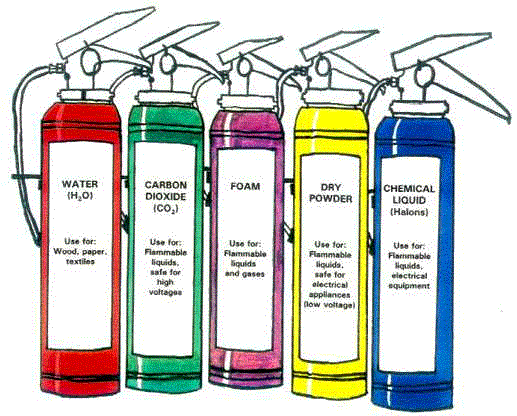
|
The responsibilities of the transporter are
|
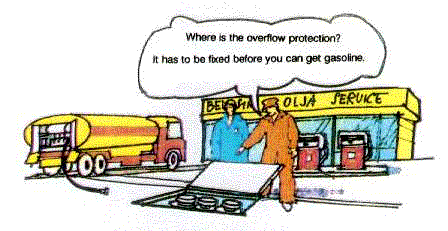
|
The driver of a vehicle is responsible for
|
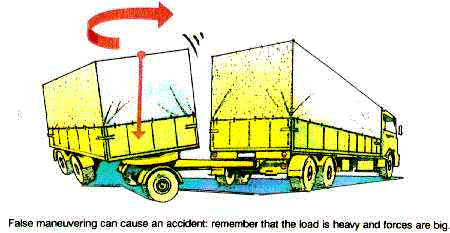
|
COMMON RULES THAT APPLY TO TRANSPORT OF DANGEROUS GOODS:
If following QUANTITY LIMITS for dangerous goods that are packed and distributed in a form intended or suitable for sale through retail agencies for consumption for purposes of personal care or household use may, be exempted from marking of the proper shipping name and UN number on the packaging and from the requirements for a dangerous goods transport documents.
List of values for quantity limits for personal care and household use: (from UN Recommendation on the Transport of Dangerous Goods)
| Class | Packing group | State | Maximum quantity per inner packaging |
| 2 2 3 3 4.1 4.1 4.3 4.3 5.1 5.1 5.2* 5.2* 5.2* 5.2* 6.1 6.1 6.1 6.1 8 8 8 8 |
- - II III II III II III II III II II II II II II III III II II III III |
Gas Gas Liquid Liquid Solid Solid Liquid or solid Liquid or solid Liquid or solid Liquid or solid Solid Liquid Solid Liquid Solid Liquid Solid Liquid Solid Liquid Solid Liquid |
120 ml* (maximum inner volume in metal or
plastic packaging) 120 ml (maximum inner volume in glass packaging) 1 litre (metal), 500 ml (glass or plastic) 5 litres 500 g 3 kg 500 g 1 kg 500 g 1 kg 100 g 25 ml 500 g 125 ml 500 g 100 ml 3 kg 1 litre 1 kg 500 ml* 2 kg 1 litre |
* special provisions according to the type of substance, the package material and size.
Example: Quantity limitations for class 9
| UN Number | Proper shipping name | Maximum quantity per inner packaging |
| 1941 1990 2071 |
Dibromodifluoromethane Benzaldehyde Ammonium nitrate fertilizers |
5 litre 5 litre 5 kg |
GOODS REQUIRING SUPERVISION
Compiled from the European Agreement concerning the international carriage of dangerous goods by road (ADR).
The lists of goods and substances in different classes presented below are not comprehensive.
Transport units carrying dangerous goods in quantities above the values indicated should be supervised or, alternatively, may be parked unsupervised in an isolated location in the open at a secure depot or factory premises.
| Class | Goods | Weight requiring surveillance xxx kg surveillance | Nature of surveillance |
| 1. Explosives: | All explosive loads | over 50 kg | all the time |
| 2. Gases: | |||
| Toxic or corrosive: | Boron trifluoride and fluorine | 1000 kg | limited |
| Ammonia, chlorine, chlorine trifluoride, hydrogen bromide, hydrogen chloride, methyl bromide, nitrogen oxides, phosgene, sulphur dioxide, tungsten hexafluoride | 1000 kg | limited | |
| Toxic and flammable: | Arsine, dichlorosilane, dimethylamine, dimethylsilane, ethylamine, hydrogen selenide, hydrogen sulphide, methylamine, methyl chloride, methyl mercaptan | 1000 kg | limited |
| Chemically unstable, toxic: | Cyanogen, cyanogen chloride, ethylene oxide, hydrogen iodide (anhydrous), methyl vinyl ether, trifluorochloroethylene (R1113), vinyl bromide | 10 000 kg | limited |
| Chemically unstable: | 1,2-butadiene, 1,3-butadiene, vinyl chloride | 10 000 kg | limited |
| Deeply-refrigerated (cryogenic) liquified: | Argon, carbon dioxide, helium, nitrous oxide (N2O), oxygen | 1000 kg | limited |
| Deeply-refrigerated (cryogenic) liquified, flammable: | Ethane, ethylene, natural gas | 10 000 kg | limited |
| 3. Flammable liquids: | |||
| Flash point below 21oC, not toxic: | Acetaldehyde, vinylidene chloride, methyl isopropyl ether,
methyl formate, isopentane, ethyl ether, isoprene, propylene oxide, normal pentane,
petroleum ether, benzene, cyclohexane, ethylbenzene(techn.), hexanes, octanes, toluene,
propylene dichloride, isopropanol, acetone, methyl ethyl ketone, ethyl acetate, methyl
acetate, vinyl acetate, ethyl acrylate, methyl methacrylate, propyl mercaptan, thiophene,
solutions containing nitrocellulose 20%-55%, solutions of 1%-5% nitroglycerine |
10 000 kg 5000 kg |
limited limited |
| Flash point below 21oC, toxic: | Acrylonitrile, acetonitrole, ethyleneimine, methyl isocyanate, allylamine 1,2-dimethylhydrazine, pyridine, chloroprene, allyl chloride, 1,2-dichloroethane, acrolein, methanol, carbon disulphide, ethyl mercaptan, some pesticides | 5000 kg | limited |
| Flash point below 21oC, corrosive: | Some chlorosilanes, isopropylamine, n-propylamine, aqueous solutions (having a boiling point less than 35oC) of dimethylamine and of ethylamine, 1,1-dimethylhydrazine, sodium methylate, acetyl chloride | 10 000 kg | limited |
| 4.1 Flammable solids: | 1000 kg | limited | |
| Explosive substances in the nonexplosive state | Musk xylene (UN No 2959) | 100 kg | limited |
| Self-reactive substances | only UN No 2951, 2954, 2970, 2971, 2972, 2973, 3033, 3034, 3040, 3041, 3042, 3043 | 1000 kg | limited |
| Self-reactive substances | Azonium zinc chlorides (UN No 3035-3039) | 100 kg | limited |
| Self-reactive substances | Valeronitriles (UN No 2953 and 2955) | all the time | |
| 4.2. Substances liable to spontaneous combustion: | Pyrophoric organic or inorganic solid n.o.s. (UN No 2846), pyrophoric organic or inorganic liquid n.o.s. (UN No 2845), white or yellow phosphorus, calcium (pyrophoric), dry metal catalyst, titanium trichloride (pyrophoric), aluminium borohydride, diethylzinc, magnesium diphenyl, metal alkyls n.o.s., metal alkyl halides n.o.s., metal alkyl hydrides n.o.s. | 10 000 kg | limited |
| 4.3 Substances which in contact with water emit flammable gases: | Ethyldichlorosilane, trichlorosilane, methyl magnesium bromide in ethyl ether, alkalimetal amalgams, potassium sodium alloys, sodium, zinc powder, calcium hydride, aluminium hydride, lithium nitride, sodium phosphide, magnesium phosphide, and their empty packagings | 10 000 kg | limited |
| 5.1. Oxidizing substances: | Aqueous solutions with more than 60% hydrogen peroxide (stabilized), perchloric acid, bromine pentafluoride, bromine trifluoride, iodine pentafluoride, potassium peroxide, sodium peroxide, oxidizing solid or liquid, toxic or corrosive n.o.s. | 10 000 kg | limited |
| 5.2. Organic peroxides: | UN No 3111 and 3112 type B UN No 3101 and 3102 type B, UN No 3113 and 3114 type C UN No 3115 and 3116 type D 3117 and 3118 type E |
500 kg
5000 kg |
all the time
limited |
| Toxic substances: | |||
| Highly toxic, flash point below 21oC | Hydrocyanic acid (completely absorbed by an inert porous substance or in the liquid state), solution of hydrocyanic acid which meet the given criteria, iron pentacarbonyl, nickel tetracarbonyl | 1000 kg | limited |
| Highly toxic, flash point 21oC or more | Acetone cyanohydrin, allyl alcohol, dimethyl sulphate, chloropicrin, thiophenol | 1000 kg | limited |
| Highly toxic, in contact with water or acids emit toxic gases | Solid cyanides or complex cyanides and their solutions, aluminium phosphide, magnesium phosphide | 1000 kg | limited |
| Highly toxic | Liquid arsenical compounds, arsenic trichloride, selenates, selenites, osmium tetroxide, tetraethyl lead, tetramethyl lead | 1000 kg | limited |
| Highly toxic, used as pesticides, rodenticides | Demphion, Demeton, Demeton-O, Dimefox, Disulfoton, EPN, Ethopropos, Fenamiphos, Fensulfothion, Fonofos, Mephosfolan, Mevinphos, Oxydisulfoton, Paraoxon, Parathion, Phorate, Pyraoxon, TEPP, Trebufos, Thionazin, Endrin, Isobenzan, Cycloheximide, Aldicarb, Promurit, Strychnine, Brodifacoum, Chlorophacinone, ANTU, Norbormide | 1000 kg | limited |
| Toxic, flash point 21oC or more | Aniline, benzonitrile, N,N-dimethylaniline, chloronitrobenzenes, dinitroanilines, dinitrotoluenes, nitrobenzene, phenylhydrazine, toluidines, xylidines, aldol, phenol, benzoquinone, cresols, diethyl sulphate, xylenols, ethyl bromide, chloroform, chloral, carbon tetrachloride, trichlorobutene, cyclohexyl isocyanate, phenyl isocyanate, 2,4-toluylene di-isocyanate, 3,4-dichlorophenyl isocyanate, tosyl isocyanate, thioglycol, triethyl phosphine, triethylene phophoramide, benzoyl cyanide | 5000 kg | limited |
| Toxic, in contact with water or acids, emit toxic gases | Sodium azide, zinc phosphide | 5000 kg | limited |
| Toxic | Dibutyl tin chloride, arsenic trichloride, arsenic pentoxide, various arsenites, mercuric acetate, mercuric chloride, mercury nitrates, selenium disulphide, selenium dioxidevanadates | 5000 kg | limited |
| Toxic, used as pesticides, rodenticides | Chlorfenvinphos, Chlormephos, Demeton-S-methyl, Dialifos, Dichlorvos, Dicrotophos, Dioxathion, Endothion, Ethion, Mecarbam, Methamidophos, Methidathion, Monocrotophos, Oxydemeton-methyl, Parathion-methyl, Phospholan, Phosphamidon, Propaphos, Schradan, Sulfotep, Triamiphos, Trichloronat, Aldrin, Dieldrin, Endosulfan, Heptachlor, Isodrin, Pentachlorophenol, Dinoseb, Dinoterb, DNOC, Aminocarb, Carbofuran, Dimetilan, Formetanate, Isolan, Mercaptodimethur, Methomyl, Mexacarbate, Oxamyl, PMA, Chloro-methoxyethyl mercury, Coumaphos, Coumatetralyl, Paraquat | 5000 kg | limited |
| 7. Radioactive substances | all the time | ||
| 8. Corrosive substances: | Bromine | 1000 kg | limited |
| Highly corrosive | Chromosulphuric acid, sulphur trioxide, oleum, red fuming nitric acid, mixtures of sulphuric acid with more than 30% of nitric acid, aqueous solutions (60-85%) of hydrofluoric acid, selenic acid, chlorosulphonic acid, chromyl chloride, disulphur dichloride, sulphuryl chloride, thionyl chloride, sulphur dichloride, boron bromide, trifluoracetic acid, aqueous solutions (more than 64%) of hydrazine, allyl chloroformate, benzyl chloroformate | 10 000 kg | limited |
| 9. Miscellaneous: | 5000 kg | limited | |
| Substances which, on inhalation as fine dust, may endanger health, Crocidolite, amosite | |||
| Substances and apparatures which in event of fire may form dioxins, PCB, PTB and their mixtures (over 50 mg/kg) |
LABELS AND DOCUMENT FOR TRANSPORT OF DANGEROUS CHEMICALS
recommended by the United Nations
Specimen labels
(* Place for class or division number as appropriate)
(** Place for division and compatibility group)
(*** Place for compatibility group)
13.5.1. CLASS 1
Explosives
Divisions 1.1, 1.2 and 1.3 . Symbol (exploding bomb): black, Background: orange
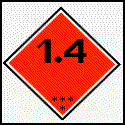
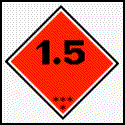
Division 1.4 (except compatibility group S*) and Division 1.5. Background: orange;
Figures: black; Numerals should be about 30 mm in height and be about 5 mm wide (for a
label measuring 100 mmx100 mm)
*The packages should be marked 1.3S
CLASS 2
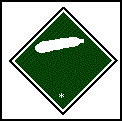
Non-inflammable gases. Symbol (gas cylinder): black or white; Backgournd: green
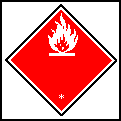
Inflammable gases. Symbol (flame): black or white, Background: red
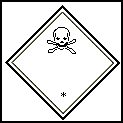
Poison (toxic) gases. Symbol (skull and crossbones): black, Background: white
CLASS 3
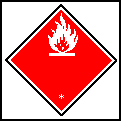
Inflammable liquids. Symbol (flame): black or white; Background: red
CLASS 4
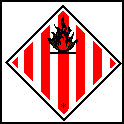
Division 4.1 . Inflammable solids, Symbol (flame): black; Background: white with vertical
stripes
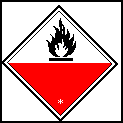
Division 4.2 . Substances liable to spontaneous combustion. Symbol (flame): black;
Background: upper half white, lower half red
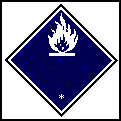
Division 4.3. Substances which, in contact with water, emit inflammable gases. Symbol
(flame): black or white, Background: blue
CLASS 5
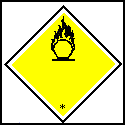
Division 5.1 . Oxidizing substances. Symbol (flame over circle): black; background: yellow

Division 5.2 . Organic peroxides. Symbol (flame over circle): black; background: green
CLASS 6
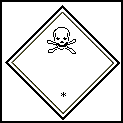
Division 6.1 . Poisonous (toxic) substances, Packing Groups: I and II, Symbol (skull and
crossbones): bladk; background: white
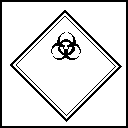
Division 6.2 . Infectious substances
CLASS 7
Radioactive substances
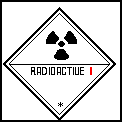
Category I- White: symbol (trefoil: black: Background: white; Text (mandatory) black in
bottom half of label: "Radioactive"; "Contents ..."; "Activity
..." . One red vertical stripe must follow the word "Radioactive".
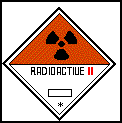
Category II- Yellow: symbol (trefoil: black: Background: top half yellow, bottom half
white; Text (mandatory) black in bottom half of label: "Radioactive";
"Contents ..."; "Activity ..." in a black outlined box."Transport
Index". Two red vertical stripes must follow the word "Radioactive".
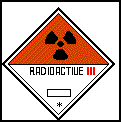
Category III- Yellow: symbol (trefoil: black: Background: top half yellow, bottom half
white; Text (mandatory) black in bottom half of label: "Radioactive";
"Contents ..."; "Activity ..." in a black outlined box."Transport
Index". Three red vertical stripes must follow the word "Radioactive".
CLASS 8
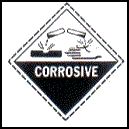
Corrosives. Symbol (liquids, spilling from two glass vessels and attacking a hand and a
metal): black: Background: upper half white, lower half black with white border.
CLASS 9
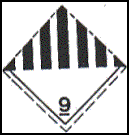
Miscellaneous dangerous substances and articles
Symbol (seven vertical stripes in upper half): black; Background: white; Figure '9'
underlined in bottom corner.
DISPLAY OF SERIAL NUMBERS
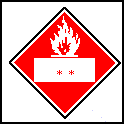
**location of serial number, * location of class or division number
DANGEROUS GOODS TRANSPORT DOCUMENT
| Shipper (Name & Address) | Reference number(s) | |
| (Reserved for text, instructions or other matter) | Name of carrier (or his agent) | |
| (Reserved for text, instructions or other matter) | ||
| Name/means of transport | Port/place of departure | |
| Port/place of destination | ||
| Marks & number; Number
& kind of packages; Description of goods* Gross mass (kg) INDICATE: HAZARD CLASS/DIV.; UN NUMBER, PACKING GROUP, FLASH POINT (in ° C c.c.) Net quantity (when required) (when required); CONTROL AND EMERGENCY TEMPERATURES (in ° C) (when required) *PROPER SHIPPING NAME (proprietary names alone are not sufficient) which should be, when required, and as appropriate: (1) preceded by the word "WASTE"; (2) supplemented by the words "LIMITED QUANTITY" or "LTD QTY"; (3) supplemented by the technical name. |
||
| Additional information Special information is required for (1) Radioactive material (Class 7) and (2) certain self-reactive and related substances of Division 4.1 and certain organic peroxides of Division 5.2. In certain circumstances (3) a Weathering Certificate or (4) a Container/Vehicle Packing Certificate is required. |
||
| DECLARATION | Name/status of signatory Place and date Signature on behalf of Shipper |
|
Page size: "A4" (210 x 297 mm or 8.27 x 11.69 inches)
HAZARD IDENTIFICATION NUMBER PLACARD
The following identification system is in use for placards in Europe (ADR) for road transport.
The background of the placard is orange. The border, horizontal line, and figures are black.
Identification numbers are shown in such a way, that the upper number is indicating the danger and the lower number identifies the substances with the UN-number given in the UN Recommendations on the Transport of Dangerous Goods.
33 |
1088 |
HAZARD IDENTIFICATION NUMBER
The hazard identification number consists of two or three figures indicating the following hazards:
| 2 | Emission of gas due to pressure or chemical reaction |
| 3 | Flammability of liquids (vapours) and gases or self-heating liquid |
| 4 | Flammability of solids or self-heating solid |
| 5 | Oxidizing (fire-intensifying) effect |
| 6 | Toxicity |
| 7 | Radioactivity |
| 8 | Corrosivity |
| 9 | Risk of spontaneous violent reaction |
Doubling of a figure indicates an intensification of that particular hazard.
Where the hazard associated with a substance can be adequately indicated by a single figure, this is followed by a zero.
If a hazard identification number is prefixed by letter 'X', this indicates that the substance will react dangerously with water.
The hazard identification number combinations have following meanings:
| 20 | inert gas |
| 22 | refrigerated gas |
| 223 | refrigerated flammable gas |
| 225 | refrigerated oxidizing (fire-intensifying) gas |
| 23 | flammable gas |
| 236 | flammable gas, toxic |
| 239 | flammable gas, which can spontaneously lead to violent reaction |
| 25 | oxidizing (fire-intensifying) gas |
| 26 | toxic gas |
| 265 | toxic gas, oxidizing (fire-intensifying) |
| 266 | highly toxic gas |
| 268 | toxic gas, corrosive |
| 286 | corrosive gas, toxic |
| 30 | flammable liquid or self-heating liquid |
| 323 | flammable liquid which reacts with water emitting flammable gases |
| X323 | flammable liquid which reacts dangerously with water emitting flammable gases |
| 33 | highly flammable liquid (flash point below 23oC) |
| 333 | pyrophoric liquid |
| X333 | pyrophoric liquid which reacts dangerously with water |
| 336 | highly flammable liquid, toxic |
| 338 | highly flammable liquid, corrosive |
| X338 | highly flammable liquid, corrosive, which reacts dangerously with water |
| 339 | highly flammable liquid, which can spontaneously lead to violent reaction |
| 36 | flammable liquid (flash-point between 23oC and 61oC, inclusive), slightly toxic, or self-heating liquid, toxic |
| 362 | flammable liquid, toxic, which reacts with water emitting flammable gases |
| X362 | flammable liquid, toxic, which reacts dangerously with water emitting flammable gases |
| 38 | flammable liquid (flash-point between 23oC and 61oC, inclusive), corrosive |
| 382 | flammable liquid, corrosive, which reacts with water emitting flammable gases |
| X382 | flammable liquid, corrosive, which reacts dangerously with water emitting flammable gases |
| 39 | flammable liquid, which can spontaneously lead to violent reaction |
| 40 | flammable self-heating solid |
| 423 | solid, which reacts with water emitting flammable gases |
| X423 | flammable solid, which reacts dangerously with water emitting flammable gases |
| 44 | flammable solid, in molten state, at elevated temperature |
| 446 | flammable solid, toxic, in molten state, at elevated temperature |
| 46 | flammable or self-heating solid, toxic |
| 462 | toxic solid, which reacts with water emitting flammable gases |
| 48 | flammable or self-heating solid, corrosive |
| 482 | corrosive solid, which reacts with water emitting flammable gases |
| 50 | oxidizing (fire-intensifying) substance |
| 539 | flammable organic peroxide |
| 55 | strongly oxidizing substance |
| 556 | strongly oxidizing substance, toxic |
| 558 | strongly oxidizing substance, corrosive |
| 559 | strongly oxidizing substance, which can spontaneously lead to violent reaction |
| 56 | oxidizing substance, toxic |
| 568 | oxidizing substance, toxic, corrosive |
| 58 | oxidizing substance, corrosive |
| 59 | oxidizing substance which can spontaneously lead to violent reaction |
| 60 | toxic or harmful substance |
| 63 | toxic or harmful substance, flammable (flash point between 23oC and 61oC) |
| 638 | toxic or harmful substance, flammable (flash point between 23oC and 61oC), corrosive |
| 639 | toxic or harmful substance, flammable (flash point between 23oC and 61oC), which can spontaneously lead to violent reaction |
| 66 | highly toxic substance |
| 663 | highly toxic substance (flash point not above 61oC) |
| 68 | toxic or harmful substance, corrosive |
| 69 | toxic or harmful substance, which can spontaneously lead to violent reaction |
| 70 | radioactive material |
| 72 | radioactive gas |
| 723 | radioactive gas, flammable |
| 73 | radioactive liquid, flammable (flash point not above 61oC) |
| 74 | radioactive solid, flammable |
| 75 | radioactive material, oxidizing |
| 76 | radioactive material, toxic |
| 78 | radioactive material, corrosive |
| 80 | corrosive or slightly corrosive substance |
| X80 | corrosive or slightly corrosive substance, which reacts dangerously with water |
| 83 | corrosive or slightly corrosive substance, flammable (flash point between 23oC and 61oC) |
| X83 | corrosive or slightly corrosive substance, flammable (flash point between 23oC and 61oC), which reacts dangerously with water |
| 839 | corrosive or slightly corrosive substance, flammable (flash point between 23oC and 61oC), which can spontaneously lead to violent reaction |
| X839 | corrosive or slightly corrosive substance, flammable (flash point between 23oC and 61oC), which can spontaneously lead to violent reaction and which reacts dangerously with water |
| 85 | corrosive or slightly corrosive substance, oxidizing (fire-intensifying) |
| 856 | corrosive or slightly corrosive substance, oxidizing (fire-intensifying) and toxic |
| 86 | corrosive or slightly corrosive substance, toxic |
| 88 | highly corrosive substance |
| X88 | highly corrosive substance, which reacts dangerously with water |
| 883 | highly corrosive substance, flammable (flash point between 23oC and 61oC) |
| 885 | highly corrosive substance, oxidizing (fire-intensifying) |
| 886 | highly corrosive substance, toxic |
| X886 | highly corrosive substance, toxic, which reacts dangerously with water |
| 89 | corrosive or slightly corrosive substance, which can spontaneously lead to violent reaction |
| 90 | environmentally hazardous substance; miscellaneous dangerous substance |